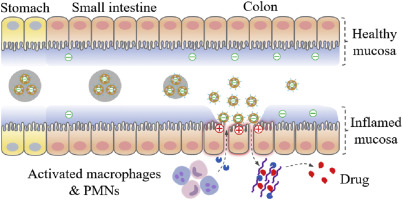Biomaterials ( IF 12.8 ) Pub Date : 2018-09-19 , DOI: 10.1016/j.biomaterials.2018.09.024 Wei Li , Yunzhan Li , Zehua Liu , Nattha Kerdsakundee , Ming Zhang , Feng Zhang , Xueyan Liu , Tomás Bauleth-Ramos , Wenhua Lian , Ermei Mäkilä , Marianna Kemell , Yaping Ding , Bruno Sarmento , Ruedeekorn Wiwattanapatapee , Jarno Salonen , Hongbo Zhang , Jouni T. Hirvonen , Dongfei Liu , Xianming Deng , Hélder A. Santos

|
Orally administrable drug delivery vehicles are developed to manage incurable inflammatory bowel disease (IBD), however, their therapeutic outcomes are compromised by the side effects of systemic drug exposure. Herein, we use hyaluronic acid functionalized porous silicon nanoparticle to bridge enzyme-responsive hydrogel and pH-responsive polymer, generating a hierarchical structured (nano-in-nano-in-micro) vehicle with programmed properties to fully and sequentially overcome the multiple obstacles for efficiently delivering drugs locally to inflamed sites of intestine. After oral administration, the pH-responsive matrix protects the embedded hybrid nanoparticles containing drug loaded hydrogels against the spatially variable physiological environments of the gastrointestinal tract until they reach the inflamed sites of intestine, preventing premature drug release. The negatively charged hybrid nanoparticles selectively target the inflamed sites of intestine, and gradually release drug in response to the microenvironment of inflamed intestine. Overall, the developed hierarchical structured and programmed vehicles load, protect, transport and release drugs locally to inflamed sites of intestine, contributing to superior therapeutic outcomes. Such strategy could also inspire the development of numerous hierarchical structured vehicles by other porous nanoparticles and stimuli-responsive materials for the local delivery of various drugs to treat plenty of inflammatory gastrointestinal diseases, including IBD, gastrointestinal cancers and viral infections.
中文翻译:

分层结构化和程序化的车辆将药物局部输送到肠道发炎的部位
口服可给药的药物载体被开发用于治疗不可治愈的炎性肠病(IBD),但是,其全身性药物暴露的副作用损害了它们的治疗效果。在本文中,我们使用透明质酸官能化的多孔硅纳米颗粒桥接酶促响应的水凝胶和pH响应的聚合物,生成具有编程特性的分层结构化(nano-in-nano-in-micro)载剂,以充分并顺序克服了多种障碍。有效地将药物局部输送到肠道发炎的部位。口服给药后,pH响应基质可保护包含药物负载水凝胶的嵌入式杂化纳米颗粒免受胃肠道在空间上可变的生理环境的侵害,直到它们到达肠道发炎的部位,防止药物过早释放。带负电的杂化纳米颗粒选择性地靶向肠的发炎部位,并响应于肠的微环境而逐渐释放药物。总体而言,已开发的分级结构化和程序化车辆将药物局部装载,保护,运输和释放到肠道发炎的部位,从而有助于实现出色的治疗效果。这种策略还可以通过其他多孔纳米颗粒和刺激反应性材料激发无数分层结构化媒介的发展,用于局部递送各种药物,以治疗多种炎症性胃肠道疾病,包括IBD,胃肠道癌和病毒感染。并根据发炎的肠道的微环境逐渐释放药物。总体而言,已开发的分级结构化和程序化车辆将药物局部装载,保护,运输和释放到肠道发炎的部位,从而有助于实现出色的治疗效果。这种策略还可以通过其他多孔纳米颗粒和刺激反应性材料激发无数分层结构化媒介的发展,用于局部递送各种药物,以治疗多种炎症性胃肠道疾病,包括IBD,胃肠道癌和病毒感染。并根据发炎的肠道的微环境逐渐释放药物。总体而言,已开发的分级结构化和程序化车辆将药物局部装载,保护,运输和释放到肠道发炎的部位,从而有助于实现出色的治疗效果。这种策略还可以通过其他多孔纳米颗粒和刺激反应性材料激发无数分层结构化媒介的发展,用于局部递送各种药物,以治疗多种炎症性胃肠道疾病,包括IBD,胃肠道癌和病毒感染。有助于取得卓越的治疗效果。这种策略还可以通过其他多孔纳米颗粒和刺激反应性材料激发无数分层结构化媒介的发展,用于局部递送各种药物,以治疗多种炎症性胃肠道疾病,包括IBD,胃肠道癌和病毒感染。有助于取得卓越的治疗效果。这种策略还可以通过其他多孔纳米颗粒和刺激反应性材料激发无数分层结构化媒介的发展,用于局部递送各种药物,以治疗多种炎症性胃肠道疾病,包括IBD,胃肠道癌和病毒感染。











































 京公网安备 11010802027423号
京公网安备 11010802027423号